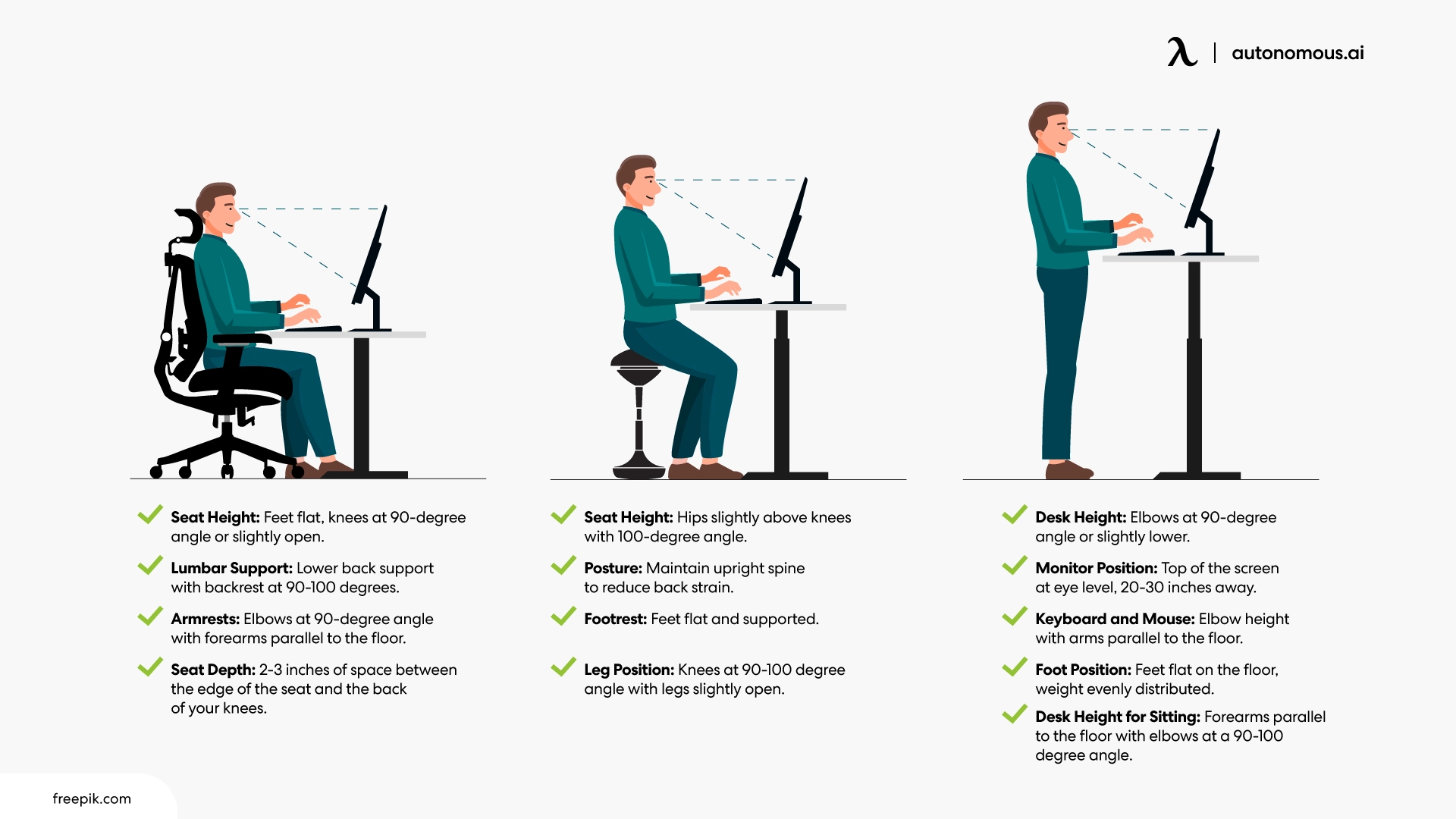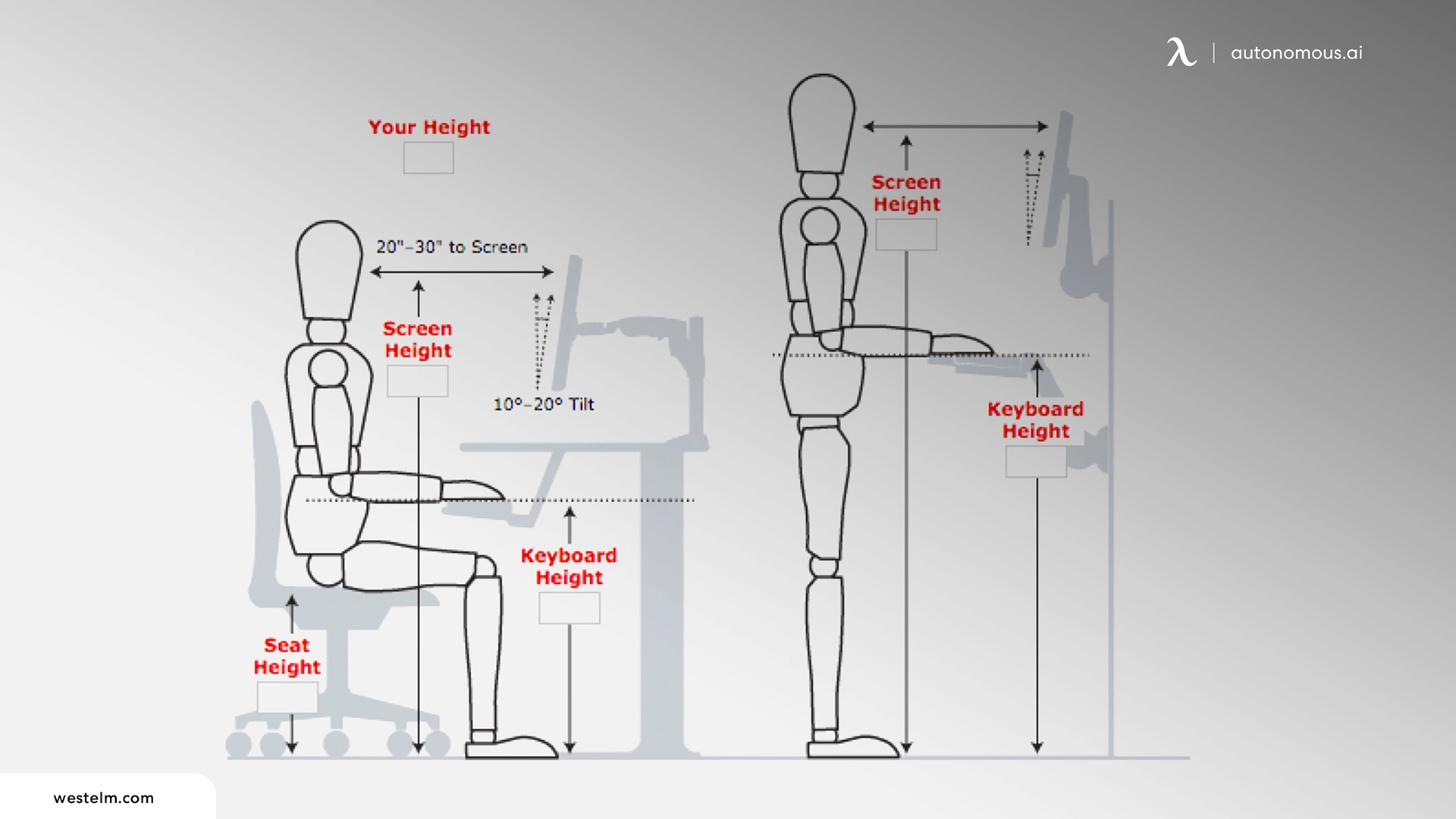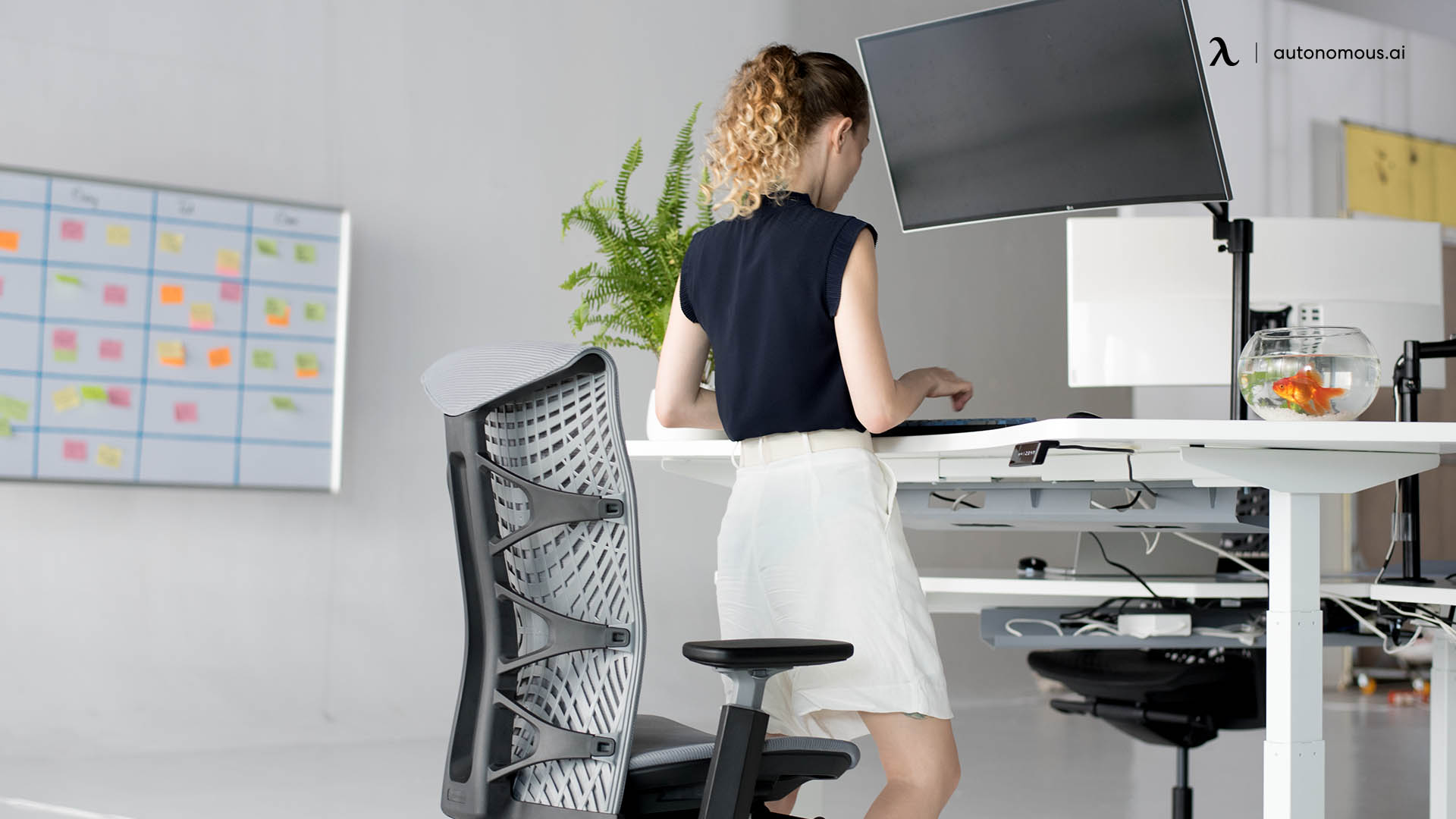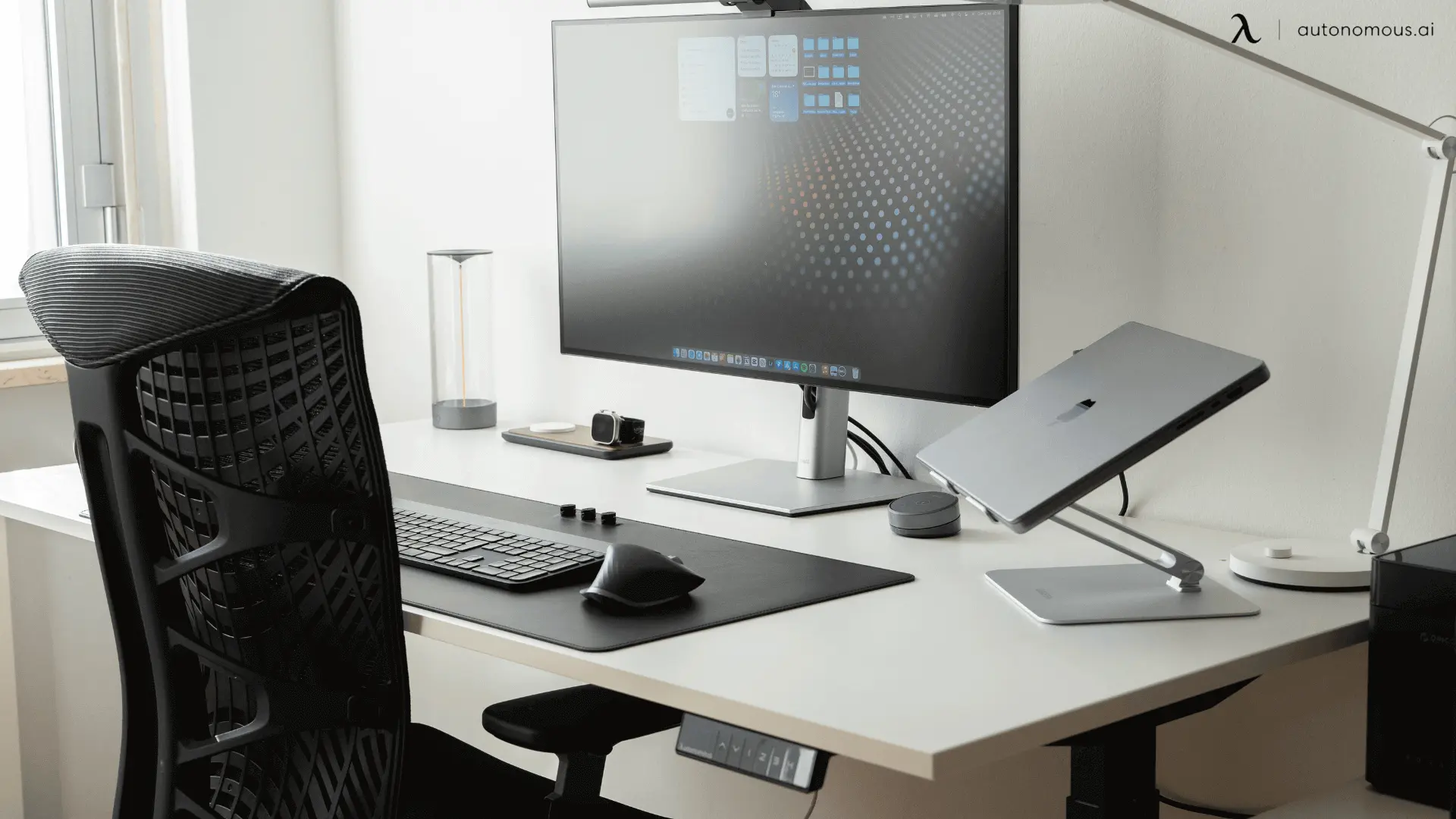
How to Determine the Ideal Standing Desk Height – Step by Step
Table of Contents
Switching to a standing workstation is a great step toward better health, as prolonged sitting is linked to obesity, metabolic syndrome, and other health issues. But have you considered the ideal standing desk height for your setup? The right desk height plays a crucial role in improving posture, comfort, and productivity while preventing discomfort.
Standing desks are growing in popularity for their ability to enhance health and work efficiency, but the key to maximizing their benefits is proper ergonomic setup. The correct standing desk height can significantly impact your comfort and well-being. To help you find the right height, use a desk height calculator for a perfect fit.
How High Should a Standing Desk Be?
The average height for a standing desk is between 38" and 46". This range allows the average person to keep their elbows at a 90-degree level angle when performing common office tasks, such as typing or using the mouse.
Additionally, these dimensions help relieve the strain on other body parts, such as our shoulders, neck, and back.
There's no typical or standard standing desk height suitable for everyone. Ideally, each person should consider multiple aspects to determine the ideal height according to their physical characteristics and needs.
If you're 5' tall, the ideal standing desk should be 37.4" high. However, it should be 43.4" high for a person who is 6' tall.
It's also important to consider other things. The distance between our eyes and the screen should be between 18" and 24".
We also have to adopt a healthy posture by maintaining:
- Our shoulders relaxed
- Adequate circulation in our legs
- Our back straight
- Our hip and knee joints in a healthy position
- Our feet flat on the floor
Some people may need to adjust the desk height throughout the day as they shift between sitting and standing.
These changes must be based on our position. As long as we feel comfortable and consider the aspects mentioned above, we can prevent strain on our bodies and maximize the benefits of standing desks.

Steps to Determine the Right Standing Desk Height
Finding the perfect height isn't a one-size-fits-all equation. Here are some additional factors to consider:
- Desk Depth: desk depth plays a crucial role. With a deeper desk, you might need to adjust the height slightly to ensure comfortable elbow positioning while maintaining proper reach for your monitor and other frequently used items. Refer to our guide on office desk dimensions feet, inch and cm to understand standard desk depths and how they might influence your ideal height.
- Monitor Placement: Monitor height is equally important. Ideally, the top third of your monitor should be level with your eyesight. This helps maintain proper neck posture and prevents strain.
Using a desk that's desk too high can lead to shoulder strain, neck pain, and wrist discomfort. Conversely, a desk that's too low can cause hunching, back pain, and fatigue.
Here's a short but comprehensive guide on the steps to select the perfect height for a standing desk. Let's check them below!
Step #1 Measure Our Elbow Height
The first thing we have to do is measure the height of our elbows from the ground. This will help us choose a desk that allows us to maintain a comfortable and healthy position while sitting or standing.
To measure this body part, we have to stand in a comfortable position, relaxing our shoulders and keeping our arms at our sides.
After that, we have to measure the distance between our elbows and the floor. We can ask someone to help us with this process. It's also essential to write down this number, as we'll use it later.
Step #2 Add Between 1" and 2" to the Elbow Height We Already Measured
Once we measure the height of our elbows, we have to add 1" or 2" to that number. The result will be the ideal standing desk height according to how tall we are.
Why should we add a couple more inches to the height of our elbows? Well, this will help us avoid strain on our shoulders and neck while working.
Step #3 Make Adjustments to Get Maximum Comfort If Necessary
Although the height we calculated with the first two steps can help us choose a comfortable standing desk, each person is unique and may want different comfort levels.
Therefore, we have to do some tests and pay attention to how we feel when using a standing desk.
If we think we need a higher-standing desk, we can make slight adjustments to achieve the ideal comfort level based on our preferences.
However, adjustments should be slight, considering the recommended minimum and maximum height. A desk that is too high would be just as uncomfortable and unhealthy.
Step #4 Level Our Monitor With Our Eyes
Adjusting the desk height is important, but we need to satisfy another strict requirement to ensure the table is comfortable enough. It has to do with our monitor.
If the position of the monitor is too high or too low in relation to the standing desk, we'll likely maintain a poor and unhealthy posture.
Ideally, the distance between our eyes or heads and the screen should be between 18" and 24". However, this can also vary depending on our physical characteristics and needs.
Overall, the maximum recommended distance between our head and the display is 16-30". If it goes out of that range, we could cause strain in our eyes and the rest of the body.
If we have trouble achieving the right height for our monitors, we can use ergonomic elevations. Monitor stands or raisers are among the most popular options because they can raise the top third of the screen to our eye level. Also, they're inexpensive and adjustable.
Step #5 Test the Standing Table Desk Height for a Couple of Days
Finally, we should test our standing desk height for a few days after making the necessary calculations and adjustments.
During this testing period, we should spend some time sitting and standing, paying attention to how our body feels.
If we experience discomfort or strain, the best thing we can do is adjust the standing desk table again or purchase another option.

Guide on Calculating Minimum and Maximum Standing Table Height
As mentioned, determining the recommended maximum and minimum standing desk height is also essential to making the right decision.
Again, this number is based on our height and should ensure a healthy and comfortable posture.
While the ideal height of a standing desk should be the distance between the floor and our elbows (90-degree angle), other factors can affect these measurements. Here are some of them:
- The use of a monitor stand or a similar device
- The height of our shoes
- The height of our monitors

However, we'll help you calculate the maximum and minimum height for a standing desk in this article. Here are the steps you should follow:
Step #1 Measure the Exact Height With Our Shoes on
This is one of the most important tips to calculate the ideal standing desk height. We should start by measuring our height while wearing our favorite shoes.
It's important to choose the shoes we usually wear when we work at our desk. This will help us have accurate measurements.
Additionally, we should stand up straight with our heels against the wall, keeping our heads level.
To make the process easier, we can use a tape measure. We should measure the distance from the ground to the top of our heads. The result will be our height.
The proper standing desk height depends greatly on our exact height with shoes on, so this step is quite important.
Step #2 Subtract 30" to Find the Minimum Standard Desk Height
After completing the first step, we must calculate the minimum standing desk height. It's way easier than you think!
We only have to subtract 30" from our height with shoes on. The result will be the minimum height we can consider when determining how tall our standing desk should be.
If we're 71" tall, the minimum desk height should be 41", for example. Considering these dimensions when choosing or adjusting a standing table ensures that we can use this piece of furniture comfortably without hunching over.
Step #3 Determine the Maximum Standard Desk Height by Subtracting 28" to Our Height
Now, it's time to calculate the maximum standing desk height. This number will help us choose a table that isn't too high, which would cause strain on several body parts, including our necks and shoulders.
In order to determine the maximum desk height, we have to subtract 28" from our height. Assuming we're 71" tall, the result should be 43".

Common Mistakes When Determining a Standing Desk Height
We're humans and can make mistakes when carrying out any activity, especially if we have to calculate heights and other measurements.
Let's go over the common mistakes most people make when determining the proper height for a standing desk, so we can avoid them and get better results.
- Use Only the Information on the Standing Desk Height Chart
Almost all standing desks come with a height chart. While this piece of information can be helpful when doing our calculations, it shouldn't be the only thing we rely on to determine how tall our table should be.
Considering our body sizes and the type of shoes we commonly wear is as important as calculating an accurate standard height.
- Forget to Consider Accessories
Accessories are essential. We often use keyboard trays, anti-fatigue mats, monitor stands, and other items that can add height to our standing desk.
If we don't consider these accessories when determining the ideal standing desk height, we'll get inaccurate measurement results, which means we'll likely have a poor and unhealthy posture.
- Ignore Our Sitting Posture
We don't just use standing desks to stand. We should switch between standing and sitting to maximize the health and comfort benefits of these pieces of furniture.
Ideally, we should calculate the right standing desk height for both sitting and standing positions.
- Setting the Desk Too High
Setting the standing desk too high doesn't mean we'll be more comfortable. Actually, this can affect our bodies by forcing us to adopt an unhealthy posture.
When the desk is too high, using it can lead to strain on many body parts. Therefore, we should always follow the recommended guidelines to determine the proper standing table height.
If we want to avoid these mistakes and be successful when setting our standing desk height, we just need to take enough time to properly measure and adjust how high this piece of furniture should be.
Additionally, we should experiment with different positions, test the chosen height for a few days, consider our needs or preferences, and pay attention to how our body feels to make the right choice.
If you encounter any discomfort after adjusting your desk height, don't despair! standing desk problems are common and often have easy solutions.

FAQs
1. What is The Proper Height for Standing Desks?
So, what is the ideal height for a standing desk? This measurement is determined by the height of the person who is using the desk, thus there is no one-size-fits-all solution. You may want to double-check this measurement because even a few inches inaccurate can cause you to hunch or hurt your neck or wrists. It's also vital to alter the height of your workstation daily, as certain shoes, such as high heels or anti-fatigue mats, can make you appear taller.
Start with your arms at your sides and your feet slightly parted, with your weight evenly divided between your legs, whether you're standing or sitting. Because everyone is unique, a customized approach to standing desk height is more accurate.
If you follow the standing desk tips below, your desk can be set up in no time!
2. How to Get the Proper Stance?
Besides proper standing desk height, stand with your feet about a foot apart and your arms straight at your sides to get the appropriate posture for a long day of work. Your head should be in line with your spine, and your eyes should be directly forward, horizontal to the floor. Your shoulders should be pushed back and down, and your chest should be front but not puffy. The optimum stance is when both legs are equally balanced. You also shouldn't lean to one side or place more force on one hip than the other. To avoid knee stress, you should maintain a modest bend in your knees rather than locking them. Visualize a string tugging up from the bottom of your waist and out the center of your head. When you're exercising great posture, you should experience that degree of elevation and alignment all of the time.
Adding onto standing upright, it's a good idea to take a little warm-up every morning to loosen up any stiff spots in your neck and back. Gentle neck rolls and spine turns can make a significant difference in your spine's function.
3. Is a Standing Desk Worth it?
After acknowledging some information about standing desk height, let’s consider a standing desk's advantages and disadvantages before buying it.
At Autonomous, we offer a wide range of adjustable standing desks, including double sided standing desks for collaborative workspaces, best pneumatic standing desk options for smooth height adjustments, and even standing desk under $500 to fit various budgets.
Spread the word
.svg)







